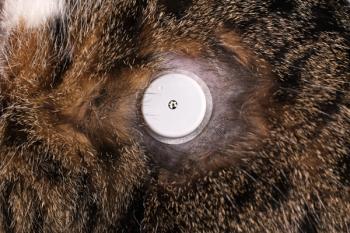
Adrenal diseases in cats (Proceedings)
There are several manifestations of adrenal disease in cats, ranging from hypoadrenocorticsm to several forms of hyperadrenal activity. All are considered relatively rare, but it is possible that we may discover some more frequently if we have a higher index of suspicion.
There are several manifestations of adrenal disease in cats, ranging from hypoadrenocorticsm to several forms of hyperadrenal activity. All are considered relatively rare, but it is possible that we may discover some more frequently if we have a higher index of suspicion.
Hypoadrenocorticism
Primary hypoadrenocorticism has been reported in few cats, but does occur spontaneously. It has been seen as idiopathic atrophy of the adrenal glands, similar to that of dogs. It has also been diagnosed in association with other illness such as trauma and lymphoma. It is also possible to see iatrogenic hypoadrenocorticism with rapid withdrawal of glucocorticoids although cats are considered to be relatively resistant to this. Relative adrenal insufficiency associated with sepsis is controversial, but has been reported recently in cats.
Regarding primary hypoadrenocorticism, the signalment is variable, there is no gender predilection. The most common clinical findings include lethargy, depression, anorexia, weight loss, polyuria, and polydypsia. The most common physical exam findings include depression, weakness, hypothermia, slow CRT, weak pulses. Occasionally, bradycardia, collapse and painful abdomen are reported.
Routine laboratory testing has revealed anemia, lymphocytosis, eosinophilia, hyperkalemia, hyponatremia, evidence of renal dysfunction with dilute urine. On thoracic radiographs, changes associated with dehydration may be noted (microcardia). EKG changes may be reflective of the presence of hyperkalemia.
Diagnosis is by ACTH stimulation test. Results showing lack of stimulation would be consistent with the diseases.
Therapy for hypoadrenocorticism is similar to that in dogs, including therapy for shock and supplementation of glucocorticoids and mineralocorticoids. Spontaneous atypical hypoadrenocorticism (hypocortisolism alone) has not been reported in cats. Long-term survival is considered to be excellent, with dedicated owners.
Hyperadrenocorticism (HAC)
Hypercortisolemia
Feline hyperadrenocorticism is a rare disease of excessive cortisol secretion by the adrenal glands. Most often this is caused by a pituitary adenoma (80%), but also may be adrenal dependent (20%). It is usually seen in middle aged to older cats with females slightly more likely to develop the disease. The disease usually involves concurrent diabetes mellitus. The most common clinical signs are insulin resistant diabetes mellitus, cutaneous atrophy, polydipsia, polyuria, abdominal enlargement, muscle weakness, recurrent infections. On physical exam the most common abnormalities include abdominal enlargement, alopecia, and thin skin with wounds.
Routine diagnostic testing reveals elevated alanine aminotransferase (ALT), hyperglycemia, hypercholesterolemia and low blood urea nitrogen. A hemogram may reveal erythrocytosis and stress leukogram. A urinalysis may appear to be concentrated due to the concurrent glycosuria.
Screening tests that can be used are the Urinary cortisol to creatinine ratio (UCCR), ACTH stimulation test, and Low dose dexamethasone suppression test. A normal UCCR has value in ruling out the disease, but an elevated result must be confirmed by further testing. ACTH stimulation tests have a low sensitivity, with only 50-60% of cats with HAC having exaggerated responses. Many cats will have a low response. There is some controversy amongst veterinary endocrinologists, but low dose dexamethasone testing is considered to be the test of choice, by some, for diagnosis of HAC in cats.
Differentiation tests include High dose dexamethasone suppression test, endogenous ACTH concentration and abdominal ultrasonography. Magnetic resonance imaging or computed tomography can be used to image either the adrenal or pituitary glands.
Medical therapy has generally been considered to be unsuccessful. Mitotane, which is cytotoxic to adrenocortical cells, has generally been ineffective in cats. Trilostane has been reported in several cats, and has had moderate effectiveness. It inhibits 3B-hydroxysteroid dehydrogenase, and can actually increase levels of some of the intermediary hormones. The significance of this is unknown at this time. The dose generally initiated in cats is 30 mg by mouth once per day, and adjusted from there. Other therapeutic options include pituitary radiation, hypophysectomy, or bilateral adrenalectomy. The prognosis is guarded to grave.
Primary Hyperaldosteronism
When Conn first described primary hyperaldosteronism in people he described three hallmarks of the disease; hypertension, hypokalemia and increased serum aldosterone concentration. Primary hyperaldosteronism is a rare condition in cats, due to aldosterone secreting adrenal tumors. There is the suspicion though that this condition may be under recognized. Aldosterone is secreted normally from the zona glomerulosa within the adrenal gland. The primary functions of aldosterone are the regulation of serum sodium and potassium balance and maintenance of vascular volume. Excess production of aldosterone may be primary or secondary. Primary hyperaldosteronism is autonomous secretion of the hormone by abnormal cells in the adrenal cortex. Secondary hyperaldosteronism is the result of disease outside the adrenal gland, such as kidney or heart disease, stimulating the adrenal glands excessively. Excess production of aldosterone by the adrenal gland leads to sodium retention, expansion of the extracellular fluid volume, increased total body sodium content, potassium wasting and hypokalemia, as well as systemic hypertension. Renin secretion is suppressed through negative feedback.
Primary hyperaldosteronism generally occurs in older cats, 10 years old and up. There do not appear to be any sex or breed predilections. Clinical signs noted in reported cat cases include weakness, polyuria, polydypsia, weight loss, ataxia, vision loss and abdominal enlargement. Physical examination may include neck ventroflexion, distended abdomen, blindness (detached retinas), and heart murmur. The most consistent finding on routine biochemical testing is hypokalemia. Urinary fractional excretion of potassium is greatly increased. Serum creatinine kinase concentrations are also greatly increased, due to hypokalemic polymyopathy.
Imaging of the adrenal glands may reveal an enlarged gland. Alternately it has been reported that the adrenal glands can appear normal in size, but have increased presence of aldosterone secreting cells dispersed throughout all layers of the tissue. Most cases are due to either an adrenal adenoma or carcinoma.
Aldosterone levels are usually elevated, but occasionally have been normal with decreased renin activity. The excessive aldosterone production can be associated with elevations of other intermediary hormones.
Medical management includes potassium supplementation, aldosterone antagonist therapy and control of the hypertension. Surgical removal of the affected gland has been performed in a few reported cats. Metastasis of the tumor has also been reported.
The prognosis is guarded depending on the underlying cause. Cats can potentially live months to years with medical management.
Progesterone Secreting Tumors
Progesterone secreting adrenocortical tumors has been reported in cats. Progesterone has a half life of a few minutes and is a precursor of other androgens, estrogen, and cortisol. Progesterone can be elevated in conjunction with other intermediary adrenal hormones. Excess progesterone can result in many of the clinical signs of excessive cortisol secretion. The clinical findings are similar, including fragile skin, diabetes mellitus, and symmetrical alopecia. A routine ACTH stimulation test or LDDST may be normal or consistent with HAC. ACTH stimulation testing with measurement of intermediary hormones would likely give the diagnosis. Often an adrenal mass is noted on abdominal ultrasound. Several have been documented as carcinomas on histopathology. Surgical removal of the affected gland has been successfully reported.
References available on request
Newsletter
From exam room tips to practice management insights, get trusted veterinary news delivered straight to your inbox—subscribe to dvm360.




